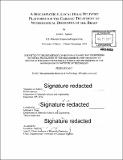A biocompatible, local drug delivery platform for the chronic treatment of neurological disorders of the brain
Author(s)
Spencer, Kevin C. (Keven Collen)
DownloadFull printable version (19.01Mb)
Other Contributors
Massachusetts Institute of Technology. Department of Materials Science and Engineering.
Advisor
Michael J. Cima.
Terms of use
Metadata
Show full item recordAbstract
Many neurological disorders are now classified as circuit disorders, in which the underlying pathology arises from a failure in dynamic communication between anatomically distinct regions of the brain. Systemic therapies are often not effective due to their untargeted nature. The injectrode is a multifunctional probe designed to treat neurological disorders through targeted chemical and electrical stimulation directly to a focal point within the implicated neural circuit. This thesis details the characterization and biocompatibility of the injectrode for the treatment of neurological disorders on chronic timescales. In vitro and in vivo infusion tests were conducted to validate the ability to deliver nanoliter scale volumes (10-1000 n1) of drug to targeted brain structures over the course of an eight week implantation period. Muscimol was delivered to deep brain structures to demonstrate effective modulation of neural activity and behavior. These findings highlight the utility of a local chemical delivery approach to treat circuit diseases of the brain. Glial scar is a major barrier to neural probe function. A main objective of this thesis is focused on understanding the process of glial scar formation from a materials perspective. Micromotion and mechanical mismatch are thought to be key drivers of scar formation. This hypothesis was investigated using a novel 3D in vitro glial scar model, which replicates the magnitude and frequency of micromotions that are observed in vivo. Astrocytes were found to have a significant increase in cellular area and perimeter in response to micromotion compared to static control wells. These findings were applied to improve the biocompatibility of the injectrode. Hydrogel coatings, with moduli matched to brain tissue, were formed to mitigate the effects of micromotion. These coatings were found to reduce local strain by up to 70%. In vivo studies were conducted to explore the impact that implant diameter and modulus have on scar formation. Hydrogel coated implants (E=1 1.6 kPa) were found to significantly reduce scarring at 8 weeks post implantation, compared to uncoated implants (E=70 GPa). Size effects from increasing the overall implant diameter were also observed, highlighting the importance of considering both mechanical and geometric factors when designing chronic neural implants.
Description
Thesis: Ph. D., Massachusetts Institute of Technology, Department of Materials Science and Engineering, 2017. Cataloged from PDF version of thesis. Includes bibliographical references (pages 148-158).
Date issued
2017Department
Massachusetts Institute of Technology. Department of Materials Science and EngineeringPublisher
Massachusetts Institute of Technology
Keywords
Materials Science and Engineering.